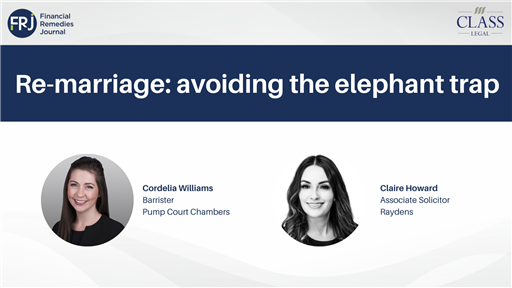
Remarriage: Avoiding the Elephant Trap
Published: 21/11/2023 07:00

This article is a practical guide to the legal consequences of a second (/third/fourth/fifth, etc) marriage, to assist when advising clients how to avoid falling into the ‘elephant trap’ of premature remarriage – a term coined by the late Singer J. It can be a messy topic, and it is surprisingly common to avoid finalising financial arrangements after the demise of a marriage. The importance of giving accurate advice to clients, particularly those keen to remarry, is obvious.
The law
As we know, upon a divorce application (‘divorce petition’ in old language) being issued, either spouse may make a financial remedy claim against the other under the Matrimonial Causes Act 1973 (MCA 1973). There is no time limit within which an application must be made, even following lengthy delay; Wyatt v Vince [2015] UKSC 14.
However, in circumstances of a remarriage, s 28(3) MCA 1973 can bite. If a spouse has remarried they lose their entitlement to apply for a financial provision order or a property adjustment order in their favour.
Section 28(3) MCA 1973 states:
‘If after the grant or making of a decree or order dissolving or annulling a marriage either party to that marriage remarries whether at any time before or after the commencement of this Act or forms a civil partnership, that party shall not be entitled to apply, by reference to the grant or making of that decree or order, for a financial provision order in his or her favour, or for a property adjustment order, against the other party to that marriage.’
The parallel provision1 is set out in Sch 5, para 48 Civil Partnership Act 2004:
‘If after the making of a dissolution or nullity order one of the civil partners forms a subsequent civil partnership or marriage, that civil partner is not entitled to apply, by reference to the dissolution or nullity order, for:
(a) an order under Part 1 in that civil partner’s favour, or
(b) a property adjustment order,
against the other civil partner in the dissolved or annulled civil partnership.’
The applications caught by the above provisions are those for:
- financial provision (s 23 MCA 1973) for periodical payments, secured periodical payments and lump sum provisions; and
- property adjustment orders (s 24(1) MCA 1973) for transfer of property, settlement of property, and variation of a nuptial settlement for the benefit of one/both of the parties.
The bite of the s 28(3) provisions does not however extend to pension sharing orders. An application for a pension sharing order can still be made following the applicant’s remarriage. Indeed, it can be a resourceful idea to focus on such a pension sharing order application if your client is in the ‘elephant trap’ of not being entitled to apply for financial provision/property adjustment orders. NB Pension attachment orders are different and classed as financial provision orders.
Another consequence of remarriage to remember is s 28(1)(a) MCA 1973 – periodical payments cannot be ordered to extend beyond the remarriage of the recipient party.
When do parties fall into the ‘elephant trap’? Timing is everything. If the applicant remarries after applying for financial remedies, even if the application has not yet been heard, the application may proceed. So the crucial question is whether a valid application for financial remedies has been made before the remarried spouse waltzes down the aisle. ‘Marry in haste, repent at leisure.’
If one spouse remarries, that does not terminate the right of the other spouse who remains unmarried to bring their own financial claims.
In E v E [2008] 1 FLR 220, Singer J related ‘a truly cautionary tale’ (at [1]). The wife’s divorce petition had included a claim for all forms of ancillary relief. The husband (respondent to the wife’s divorce petition) had made no application for financial remedies. After decree absolute, the parties negotiated a financial settlement through their solicitors, and drafted and signed a consent order. After the consent order drafting was finalised, but before any application to the court had been made, the husband remarried in Bali at ‘a ceremony which, certainly the date if not the place of which, he now no doubt deeply regrets’ (at [1]).
The ‘brutal outcome’ for the husband was that he fell into the ‘elephant trap of premature remarriage’ (at [14]). Singer J determined: ‘the court was never seised and the court’s jurisdiction was never invoked until after the husband had remarried and put it beyond the court’s power to contemplate and deal with his application’ (at [14]). ‘I cannot make bricks without any straw, and s.28(3) of the 1973 Act burns the straw. There is no jurisdiction. I refuse the husband’s application’ (at [17]).
Given that the only order sought was for the wife to pay the husband a lump sum, Singer J considered the divorce petitioner wife could not apply for such an order against herself, even if she were minded to do so: ‘It would be absurd if you could make an order in favour of a remarried spouse because the other spouse was asking you to, but you could not if that spouse him or herself were asking for the same relief’ (at [13]).
Income
Turning first to income claims, the remarried party cannot pursue a periodical payment claim but the party who has not remarried may do so, assuming it is in their interests. This is in line with the maintenance bar under s 28(1)(a) MCA 1973 pursuant to which payments cease following the receiving party’s remarriage. NB This is not to be confused with a s 28(1A) bar on the extension of the maintenance term.
Capital
The capital position can be tricky. There could be circumstances, for example, where one spouse allowed the other to remain in the family home with the children upon divorce but they failed to formalise the arrangements. Following the non-resident spouse’s remarriage, they cannot pursue an application for a transfer of the family home, or settlement of the family home (e.g. a Mesher order) under the MCA 1973, and therefore the arrangement could continue indefinitely given it may not be in the resident party’s interests to issue a financial remedies application. It is likely in that scenario the non-resident party would try to find grounds to pursue alternative claims.
What are the alternatives when in the ‘elephant trap’?
If there is owned property, and the facts merit it, a remarried party can make a claim under the Trusts of Land and Appointment of Trustees Act 1996 (TLATA), or an application under the Married Women’s Property Act 1882.
Note that using TLATA as an alternative remedy is available only where there is no jurisdiction under the MCA 1973 (i.e. there is no MCA 1973 application from either party before the court); Tee v Tee and Hillman [1999] 2 FLR 613.
Is there a valid maintenance agreement in accordance with s 34 MCA 1973? Even after remarriage, the court retains the power to enforce a maintenance agreement; T v R (Maintenance after Remarriage: Agreement) (Rev 1) [2016] EWFC 26.
Another option worth exploring is a Sch 1 Children Act 1989 claim for financial provision for the benefit of a child, albeit there are limited circumstances where this will be relevant.
As stated above, an application for a pension sharing order remains an option regardless of remarriage. The Welfare Reform and Pensions Act 1999 did not amend s 28(3) MCA 1973 to include a pension sharing order as a form of financial relief, so remarriage does not prevent such a claim. Most commentators assume this was an oversight and consider s 28(3) MCA 1973 should have been amended on the introduction of pension sharing.
The application
Obviously, remarriage obstructs important financial applications for the remarrying spouse. Some claims are preserved when a financial remedies application is issued before the spouse’s remarriage, even if other claims cannot be pursued thereafter (e.g. income claims by the remarried receiving party).
What then is a valid application for financial remedies? An application can be made in an application for a divorce in Form D8 (divorce petition in old language) or a request for a financial order in Form A/A1. The latter triggers the timetable to be set out for contested court proceedings. But financial claims can be also protected at the outset by the divorce application.
Both the old divorce petition and the new divorce application forms conclude with ‘the prayer’ in which a request is usually made for an order for financial provision to be made by the court. If the ‘yes’ box is/was ticked, the applicant’s ability to pursue financial order claims is preserved. Similarly, this is the case in a cross application from the other party to the divorce application, or a joint divorce application, should that be relevant.
It is important to note the respondent’s bare acknowledgement of the divorce petition is not enough to preserve their own financial claims. In Hargood (formerly Jenkins) v Jenkins [1978] Fam 148, a ‘mere answer given in an acknowledgment of service’ to a divorce petition, indicating an intention to bring financial remedy proceedings, was not sufficient to constitute an application, and it could not circumvent the s 28(3) MCA 1973 bar when the wife had remarried.
The new answer form to a divorce application does not contain the same tick box for the respondent to indicate that they seek to bring a financial remedy claim, save that it may be serviced by ticking ‘other’ and filling in the relevant detail under ‘orders requested’. This has not been tested, and in light of the strict approach in Hargood (formerly Jenkins) v Jenkins, it should be approached cautiously.
Prudent advice may therefore be that either an appropriately completed divorce application, cross-divorce application, or Form A is required to count as an application for a financial remedies order.
When is issuing Form A/Form A1 necessary? The answer will differ depending on whether the remarrying spouse is the applicant or respondent in the divorce application. If they are the divorce applicant it is clearly helpful if they ticked the financial claims box in the divorce application. If they then wish to pursue a financial remedy claim, a Form A/Form A1 may be issued at their chosen time, including after their remarriage.
If the remarrying party is the respondent in divorce proceedings (and/or were the divorce applicant but failed to tick the financial claims box), then a Form A/Form A1 application would need to be issued before their remarriage.
Often it will be sensible for proceedings to be issued promptly via Form A/Form A1 prior to the party’s remarriage to preserve as many financial claims as possible. Any client keen to tie the knot again must give serious thought as to whether to apply for financial provision first.
Piggyback claims
The clear wording of the MCA 1973 statute precludes any application being made by an elephant trapped spouse: ‘that party shall not be entitled to apply … for a financial provision order in his or her favour, or for a property adjustment order, against the other party to that marriage’ (s 28(3) MCA 1973).
Is remarriage a bar to provision being made in the remarried elephant trapped party’s favour when the court is determining the other spouse’s financial remedies application? Can a remarried spouse piggyback their claims on their former spouse’s application?
Debate on this issue spans 40 years of jurisprudence. According to Robin v Robin [1983] 4 FLR 632, cited by Thorpe LJ in Whitehouse-Piper v Stokes [2008] EWCA Civ 1049, a remarried spouse cannot rely on the other spouse making an MCA 1973 application on which to piggyback their claims. In Whitehouse-Piper, Thorpe LJ said:
‘[5] The case of Robin v Robin is now antique, and any decision on the application of section 28(3) can only be drawn from the judgment of Dunn LJ, who at that point spoke obiter. However, in his obiter dictum he was very plain that if the court’s jurisdiction rests solely on an application by one spouse, the other spouse cannot as it were find his jurisdictional base within that application. A respondent to a divorce petition had to issue some application, either by way of prayer within an answer or by issue of application thereafter, in order to found jurisdiction.
[6] The judge surmounted the difficulty which he had himself observed by reference to a much later decision of this court in Tee v Tee and Hillman [1999] 2 FLR 613, where the court had particularly disapproved of parties engaging in TOLATA proceedings when their fundamental dispute related to a property and nothing else but a property where the court in doing justice was not restricted to proprietary law but could have regard to all the circumstances imported by the court’s section 25 jurisdiction. And that is how the judge overcame the jurisdictional problem.’
However, notwithstanding the above, it is interesting to note that in Whitehouse-Piper, neither the District Judge at first instance, the Circuit Judge on appeal, nor the Court of Appeal on the second appeal considered there was any jurisdictional obstacle to the court making a property adjustment order in favour of the remarried husband, despite the fact only the (jurisdictionally-sound) wife’s Form A was before the court.
It may be argued that too much gloss has been put on a purist reading of the statute wording. Section 28(3) bars entitlement to make an application: ‘shall not be entitled to apply’. This differs from the wording used in s 28(1)(a) for periodical payments – where the order simply cannot extend beyond the remarriage of the payee: ‘the term … shall be so defined as not to extend beyond … the remarriage’.
Section 28(3) itself does not explicitly impede the court making financial provision/property adjustment orders in favour of the remarried spouse. Sections 23 and 24 MCA 1973 refer to the court’s powers to order financial provision by one party in favour of ‘the other party’. Does the combined effect of these provisions mean that the statutory prohibition is limited to applications?
It remains to be seen how the higher courts would determine this debate. In CB v EB [2020] EWFC 72, Mostyn J referred to a similar issue as a ‘problematic question’, albeit one he did not need to resolve in that case (at [70]). Mostyn J did comment he was ‘not convinced’ by the argument that ‘the bar on the [remarried] husband issuing an application does not prevent the court from varying the orders in his favour’ (at [68]), but that if the matter (on the facts of that case) needed determination by a higher court in the future then the question of whether the remarried husband was statutorily barred from having his application determined would have ‘to be looked at very carefully’ (at [70]).
Notably, it was a recommendation of the Financial Remedies Working Group in 2014 (chaired by Mostyn J and Cobb J) that the Form A should be amended, so that once Form A is issued by one party to the marriage, all possible financial order applications by both parties should be deemed to have been made, and may be granted or dismissed by the court without further application.2
A recent Isle of Man appeal decision, Hyslop v Hyslop 2DS 2022/13 and 2DS 2023/03, offers detailed analysis of the England and Wales remarriage authorities and reaches some interesting conclusions. It is mentioned in passing that the Isle of Man appeal tribunal included Michael Horton KC (from Coram Chambers) sitting as an Acting Deemster. The Isle of Man court observed this same point about Whitehouse-Piper (at [172]):
‘what this case does show is that even where the [remarried] husband, the net recipient of capital under the order, had not made an application, it was open to the court on the wife’s application to make an order in his favour, provided that that had been made clear as part of the proceedings’
The Isle of Man court also commented (at [156]):
‘While Dunn LJ [in Robin v Robin] expressed himself in strong terms that the court could not make an order for ancillary relief in favour of A unless A had made an application for such an order, Eveleigh LJ refrained from deciding the case on that basis. As such, in our judgment, the ratio of Robin says nothing about the remarriage trap.’
The Isle of Man court’s determinations in Hyslop on piggybacking are emphatic and provide interesting reading, albeit they explicitly fell short of suggesting: ‘once one party makes an application for ancillary relief, all matters were before the court’ (at [182]). At [181] the court concluded:
‘(1) although it was suggested in Robin v Robin that it is not open to make, for instance, a property adjustment order in favour of a party who has not themselves made an application for it, in our view that is wrong. It is open for Party A to apply for orders against themselves. On such an application, an order could therefore be made in favour of Party B.
(2) where no application is made by Party A for orders against himself or herself, and Party B has remarried before making any application, and Party A has all the assets, the court cannot make any order in favour of Party B: E v E. …
(5) given that lump sum provision and property adjustment provision is seen as equivalent, we consider that a court is not precluded from making one or other order in favour of a person who is caught by the remarriage trap provided that such a person is not the net recipient of capital under the overall order. For instance, take a straightforward case where the only significant asset is the matrimonial home held in joint names. The wife applies for financial provision and the husband makes no such application, and then subsequently remarries before the wife’s application is determined. On her application, the wife seeks an outright transfer of the home into her sole name. The husband’s response is to accept a transfer from the wife from the joint names of the parties into the wife’s sole name, but with a charge back on Mesher terms, deferring the sale or realisation of the husband’s interest until the children had grown up. There is no reason why the court could not make that order even though the husband was caught by the remarriage trap, provided that the husband’s deferred interest did not exceed 50% (i.e. he was not the net recipient of ancillary relief). Such an order could be done in a number of ways, but could include effectively a lump sum order in favour of the husband with a deferred entitlement to the lump sum, and the wife undertaking to provide security for the payment of that lump sum as a condition of the transfer to her of the former matrimonial home. Such an order is perfectly permissible notwithstanding his remarriage.’
Conclusions
One of the origins of s 28(3) MCA 1973 was a report by the Law Commission dated July 1969.3 The Law Commission said:
‘A wife who has gone through a form of marriage with a second “husband” should not, in our view, be entitled to revive her rights against her first husband by having her second “marriage” annulled. If the annulment is in England, the English courts have power to order financial provision from the second “husband”. If it is in a foreign country, the courts of that country may not have that power, and she may be left without rights against either husband. But in our view, the principle must be that once another marriage has been contracted, that destroys any claim against a former spouse.’4
The report uses gender assumptions and stereotypes throughout its recommendations on this topic. Perhaps this adds weight to the argument that s 28(3) MCA 1973 was more relevant in the days when a remarried wife was seen as her new husband’s responsibility. Arguably, the sharing principle is completely undermined when the s 28(3) provision bites.
It will be interesting to see how this subject develops.










